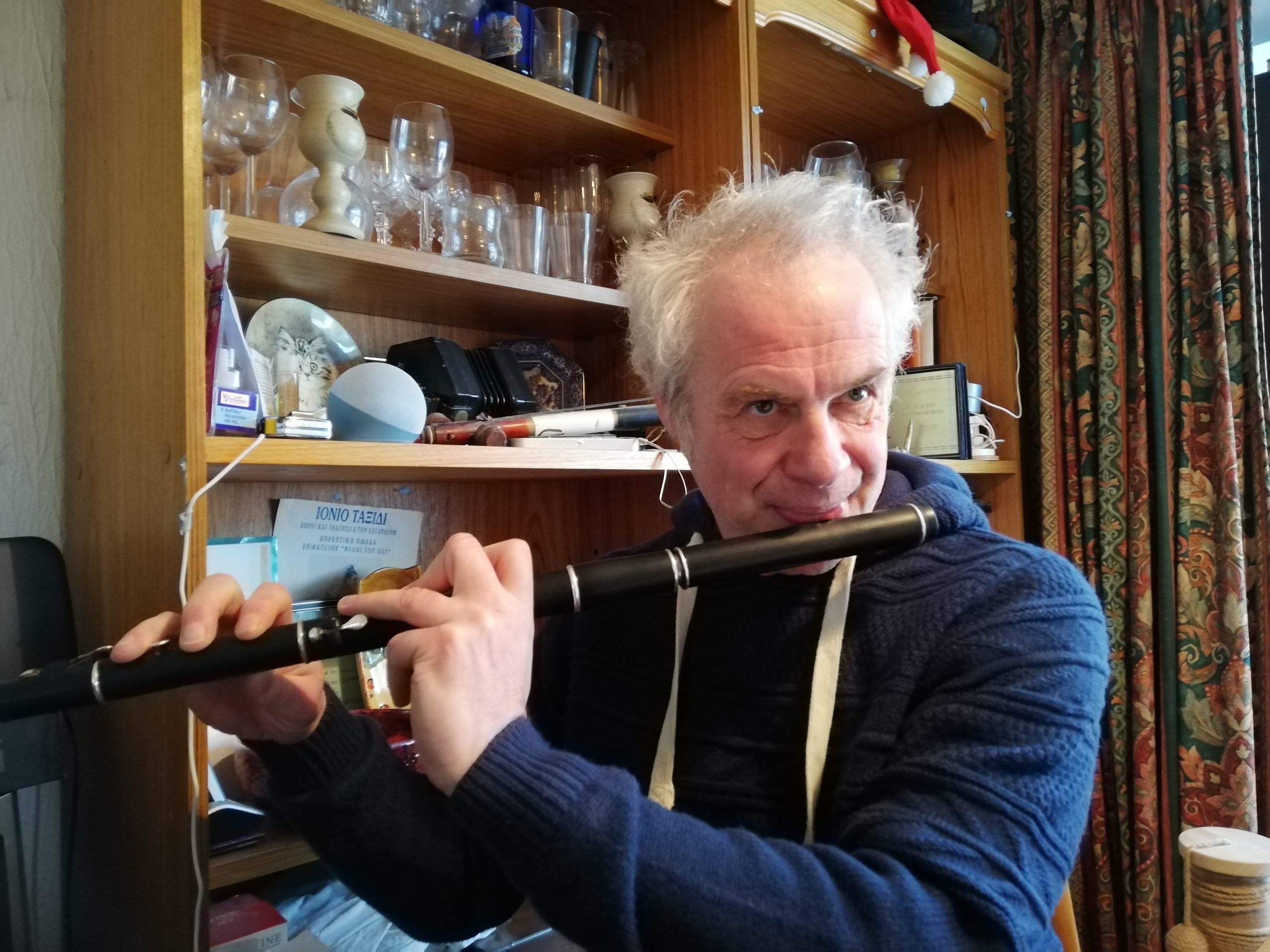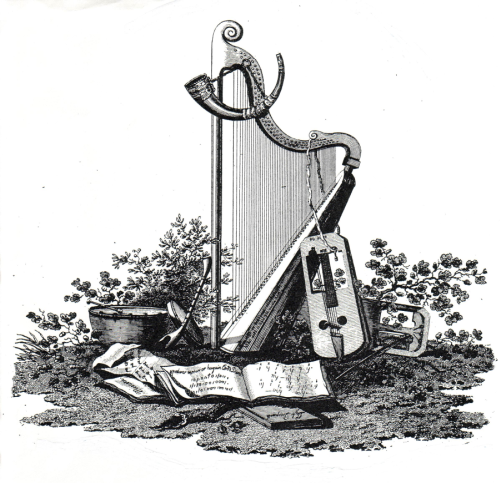
Time for a tune: Ceri Rhys Matthews shares a session with tabwrdd player Mick Tems and fiddler Olly Athelstan-Price
Musician and Welsh music visionary Ceri Rhys Matthews lives with his golden-voiced wife Julie Murphy many miles away in the West Wales village of Pencader, Carmarthenshire (writes Mick Tems.) Nowadays, he is preoccupied with his music tutoring, his Yscolan workshops in Pembrokeshire and The Gallery arts centre in High Street, Swansea, and both he and Julie delight the dancing crowd at the occasional twmpath in the village hall of the tiny community of Abercych, situated on the borders of north Pembrokeshire, Carmarthenshire and Ceredigion. But his main calling is Y Gwythienne – a tune project which reconnects with Swansea via the local melodies, played for musicians who had made their home in the ancient town, from 1717 to the present day. Ceri has created years and years of research work, and has recorded a solo vinyl LP which spotlights an impressive 40 dance tunes and beautiful airs of his birthplace. He demonstrates his notes on the flute, then very popular for hundreds of Welsh players but has slipped into historical ignominy.
Ceri was born in his home town of Swansea, now a proud city with a major industrial history of copper smelting: “I lived in North Swansea, in Treboeth, which was an industrial part and a Welsh-speaking part. It’s all changed, now – the industry and the Welsh speakers have all gone.
“It was a village with a history of coal mining. Northern Swansea was copper and tin, and this is what the record is about. In copper smelting, you needed to have a particular type of coal to achieve the very high temperatures – but the valleys coal is too soft, and the West Wales anthracite is too hard. In my valley I lived in, there was a stream and a corn mill which converted into a copper smelter in 1770 – but in our valley, it was just right. Coal seams drifted to the surface and the River Tawe was navigable, up to a point; ships loaded with copper from Valparaiso and Santiago could dock, and Swansea became the centre of the copper trade.”
The first copper works in Swansea were established in Landore in 1720 by Dr Lane and Mr Pollard, who had owned copper mines in Cornwall – the county was just across the sea, near to Swansea and the copper smelters. Three to four tons of coal was needed to smelt one ton of copper ore, so it made economic sense to bring the ore to the coal. Swansea was nick-named ‘Copperopolis’ by industrialists and its inhabitants.
Ceri left Swansea and settled in Pencader, but he returned to the city to care for his dying father in his last weeks: “My dad was born in Treboeth, and he always lived there,” he said. “It was an intense and an exhausting time for me. I walked the streets I was born in, just to clear my head – but memories came back.
“Swansea had changed, but it was all the same. I remembered the way to go everywhere, but my feet and my legs remembered more than my head. Memories began to reawaken in my mind, not superficial thoughts but deep memories – and it took the form of music. I began to perceive the place in a different way.
“Everything jelled and coalesced in my head – and they’re not compositions, but traditional tunes. It’s a nuanced and complicated process, and it seeped into me; they’re historical melodies, but they’re nebulous and hard to grasp. They came through just walking the streets and being there, reading and listening – it’s a complicated process of the tunes revealing themselves. That’s why I focused on Swansea, because it’s a very rich field, so much stuff there – my mabinogi. The chapels, the theatres, the marching bands, the individual musicians, the immigrants who helped the city to grow, the Welsh who were already here – all meshed into the connections with Swansea, the gwythienne.”
However, out of the many traditional tunes on Y Gwythienne, Ceri wrote just the one – ‘Heol Ddu’: “Heol Ddu was two streets away. As my dad was in his last weeks, I would go walking up Heol Ddu – I remember the feeling in my legs, the inclines, the turns and bends and the dips, which turned into a melody.
“So these are the tunes that I had forgotten that have come back to me, culturally and personally. I think the music that we play is a shared music – it’s a cultural music. It’s not music of the individual, it’s music of the collective. You pick things up from each other. It’s a selection that I had to make – I’ve got hours and hours of melodies, about 600 tunes that I could pull down. The best way is to share them with people; recording them is fine, but the best way is to share. in fact, there’s a bunch of us playing the local tunes.”
Ceri says that in the Swansea Welsh vocabulary, gwythienne (or gwythiennau) translates as connections or strands – the tendons in your hand are gwythienne, the finger nails are gwythienne, the connecting streams are gwythienne, even the coal seams are gwythienne y glo ; copper wires, the great connectors, are gwythienne. Ceri says that even the grooves on his vinyl LP are gwythienne – “They’re lines of connection, and that’s why I love this tangible thing.”
Y Gwythienne was the fruits of Ceri’s painstaking research. He recorded 40 dance tunes, from the opening ‘Moliant Gweithwyr y Morfa’ to ‘Nel Morse, Queen of the Mera’ in Side One and from ‘Freda Gibbons Tin Whistle’ to ‘The Green Grounds’/’Cel Waun y Llefrith’ on Side Two. The tune titles are very evocative, such as ‘The White Spelter Smoke’, ‘The Cow Ate The Vetch’ and ‘Tommy Jenkins’ Hornpipe’ (Tommy, Swansea guitarist, crumhorn player and Welsh traditional music pioneer, had taught the tune to Ceri), ‘The Cambrian Place Assembly Rooms’, ‘The King of Swansea’, ‘Cŵen y Gwair Lan Mynyddgarnllwyd’ and ‘The Dandy of Goat Street’.
Incidentally, the tune was dedicated to Nel Morse. Ceri says that the Mera was a lively old part of Neath, a few miles from Swansea. She kept a pub there – Ceri thinks it was The Crown – and was married to an Irishman, whose name was Morse. He was the harper at opera singer and diva Adelina Patti’s castle and miniature theatre in Craig y Nos, situated in the Upper Swansea Valley.
According to Ceri, the flute was commonplace in Wales. In what he calls “the Regency, the Napoleonic era”, villagers and townspeople would form militias, the yeomanry and the volunteers; the band music always consisted of flutes and drums. Notable musicians and song collectors played flutes: “Iolo Morgannwg played the flute, Ifor Ceri, John Jenkins, John Howell of Carmarthen, John Parry and so on – nobody could afford harps.
“William Burton Hart, flute player and band master, published a dance-tune volume in 1811. He came from London but lived all his life in Swansea. Flutes were much more common – hundreds of people played them. Harps were the instruments for only the higher echelons. Anyway, in the process of nation-building and national identity, flute playing got disappeared – got forgotten about.”
In Y Gwythienne, most of the tunes take on an Irish influence; Ceri says that Swansea and Cork City had strong connections with the copper trade, and Irish workers – and traditional musicians – flocked to Wales. Many little instruments, such as flutes, pibgorns, tabwrdds, crwths and Victorian diatonic accordions, were considered non grata by the harp-playing crachach. One example is the true story about the nineteenth-century Roberts family, the Romani triple-harp ‘choir’, of whom Queen Victoria was a notable patron. After the concerts had concluded, they all sat around the open campfire and relaxed – by playing mouth-organs.
In fact, Ceri started the monthly Wednesday session in Dolgellau and the local area about twenty years ago; Sesiwn Ioan Rhagfyr was named after Dolgellau flautist John Williams, who was born in 1740. He was one of the first historically recorded flute players in Wales. He also composed dance music for the flute, and he died in 1821. However, Ceri has bowed out: “Dolgellau is too much for me,” he says. “I can’t do the driving. I prefer to stick to my own little world, from Aberystwyth to Swansea – I have all the music I need here. But the session is still going strong, about 15 players. Jem Hammond the flute player is still organising it.”
What about the wonderful and eclectic fernhill, Julie and Ceri’s vision? fernhill performed for numerous festivals around Wales and Europe and recorded a number of inspiring albums on the Beautiful Jo and Disgyfrith labels; many musicians played in the band, including Jonathan Shoreland, Andy Cutting, fiddler and crwth player Cass Meurig, Burum trumpeter Tomos Williams, Welsh rapper Nobsta Nutts and violinist Christine Cooper. However, Christine’s health seriously deteriorated and she eventually ended up in a wheelchair: “We didn’t want to play without Christine, so we stopped. The good news is that she’s getting better; she had M.E., but she’s young enough to recover. This summer, I’m doing musical things with Christine, and perhaps Julie will collaborate together. Julie and me are still continuing, exploring the music. But fernhill is ended now – we’re still very good friends, but Tomos is still carrying on with his jazz playing. We’re all heading off in different directions.”
With fernhill, one of the high spots was Ceri’s amazing guitar playing – however, he’s given up on his instrument for now: “I was never a guitarist”, he admits. “I really had to work on it. The guitar is still in our room, in the corner. Our son, Aneurin, will have it – he and our other son, Rhys, are both in their thirties. And I want to explore the Welsh bagpipes…”
